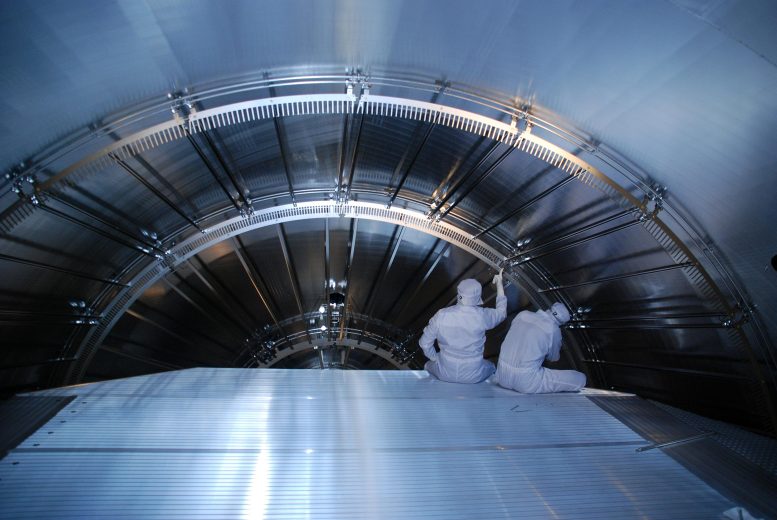Neutrinos are lighter than 0.8 electron volts
New world record: The KATRIN experiment limits the mass of a neutrino with unprecedented precision.
Neutrinos are arguably the most amazing elementary particles in our world. In cosmology they play an important role in the formation of large-scale structures, while in particle physics, their small but non-zero mass separates them from each other, indicating new physical phenomena beyond our current theories. Without measuring the mass scale of neutrinos, our understanding of the universe will remain incomplete.
Scientists often refer to neutrinos as a “ghost particle” because they never interact with other matter.
This is the international challenge karlsruhe TRItiom nThe eutrino experiment (KATRIN) at the Karlsruhe Institute of Technology (KIT) with partners from six countries is the world’s most sensitive meter for neutrinos. It uses the beta decay of tritium, an unstable hydrogen isotope, to determine the mass of a neutrino via the energy distribution of the electrons released in the decay process. This requires a major technical effort: the 70-meter experiment includes the world’s densest tritium source as well as a giant spectrometer to measure the energy of the decay electrons with unprecedented accuracy.
The high quality of the data after the start of scientific measurements in 2019 has been continuously improved over the past two years. “KATRIN is an experiment with the highest technological requirements and now works like the perfect watch,” enthuses Guido Drexlin (KIT), project lead and one of the speakers involved in the experiment. Christian Weinheimer ([{” attribute=””>University of Münster), the other co-spokesperson, adds that “the increase of the signal rate and the reduction of background rate were decisive for the new result.”
Data analysis
The in-depth analysis of this data was demanding everything from the international analysis team led by its two coordinators, Susanne Mertens (Max Planck Institute for Physics and TU Munich) and Magnus Schlösser (KIT). Each and every effect, no matter how small, had to be investigated in detail. “Only by this laborious and intricate method we were able to exclude a systematic bias of our result due to distorting processes. We are particularly proud of our analysis team which successfully took up this huge challenge with great commitment,” the two analysis coordinators are pleased to report.

The 70 meter long KATRIN experiment with its main components tritium source, main spectrometer and detector. Credit: Leonard Köllenberger/KATRIN Collaboration
The experimental data from the first year of measurements and the modeling based on a vanishingly small neutrino mass match perfectly: from this, a new upper limit on the neutrino mass of 0.8 eV can be determined (Nature Physics, July 2021). This is the first time that a direct neutrino mass experiment has entered the cosmologically and particle-physically important sub-eV mass range, where the fundamental mass scale of neutrinos is suspected to be. “The particle physics community is excited that the 1-eV-barrier has been broken by KATRIN,” comments neutrino expert John Wilkerson (University of North Carolina, Chair of the Executive Board).
Susanne Mertens explains the path to the new record: “Our team at the MPP in Munich has developed a new analysis method for KATRIN that is specially optimized for the requirements of this high-precision measurement. This strategy has been successfully used for past and current results. My group is highly motivated: We will continue to meet the future challenges of KATRIN analysis with new creative ideas and meticulous accuracy.”
Additional measurements should improve sensitivity
KATRIN spokespersons and analysis coordinators are very optimistic about the future: “Additional neutrino mass measurements will continue until the end of 2024. To realize the full potential of this unique experiment, we will not only increase the statistics of signal events, we are constantly developing and installing improvements to further reduce the background rate.”
The development of the new detector system (TRISTAN) plays a defining role in this, allowing KATRIN from 2025 onwards to begin searching for “sterile” neutrinos with masses in the kiloelectronvolt range, a candidate for the mysterious dark matter in the universe. which has already manifested itself in many astrophysical and cosmological observations, but its particle-physical nature is still unknown.
Reference: “Direct measurement of neutrino mass with sub-eV sensitivity” Feb 14, 2022 Available here. Nature Physics.
DOI: 10.1038 / s41567-021-01463-1

“Certified music scholar. Freelance analyst. Social mediaholic. Hipster-friendly web nerd. Zombie buff.”

